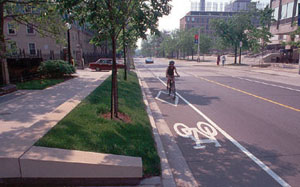Diamond lane
This article relies largely or entirely on a single source. (December 2020) |

In the United States and Canada, a diamond lane is a special lane on a street or highway that is reserved for specific types of traffic. These lanes are usually marked with white diamonds or lozenge, hence their name. Diamond lanes are generally the right-most or left-most lane on the road. They are usually implemented to provide ways through traffic congestion, for safety reasons, and to encourage environmentally friendly transportation. A diamond lane may be intended for a specific type of traffic, or for several types. The intended use of a diamond lane is marked by traffic signs. In most areas, violating the rules of a diamond lane is punishable by a fine.
Some common examples are:
- High-occupancy vehicle lane (HOV), also known as a carpool lane. These are typically freeway lanes intended for multiple occupant or "green vehicles" (such as hybrid or electric cars).
- Bike lane, sometimes referred to as segregated cycle facilities. Separating bicycle traffic from pedestrian or motor vehicle traffic is typically safer and improves traffic flow.
- Bus lane, an uncongested lane for buses to travel, load, or unload in.
- Emergency vehicle lane, to help emergency vehicles get to their destination as fast as possible while avoiding traffic congestion.
- Taxicab lanes, most often found at airports or other transit hubs for passenger loading and unloading.
- Horse and buggy lanes in areas with significant Amish populations
In some cases, these lanes may serve multiple functions. For example, a diamond lane may be designated for buses, bicycles, and right turns.
Standards[]
The Federal Highway Administration's Manual on Uniform Traffic Control Devices states that diamonds indicates a lane reserved for high-occupancy vehicles.[1]
See also[]
- Reversible lane
- Local lane
- Bike lane debate
References[]
- Road traffic management